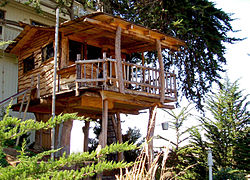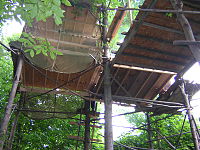
Tree house
About this schools Wikipedia selection
This content from Wikipedia has been selected by SOS Children for suitability in schools around the world. SOS Children is the world's largest charity giving orphaned and abandoned children the chance of family life.
Tree houses, treehouses, or tree forts, are buildings constructed among the branches, around or next to the trunk of one or more mature trees, and are raised above the ground. Tree houses are built and used for recreation, as temporary retreats, and even for permanent habitation.
Shelter
Tree houses are an option for building eco-friendly facilities in remote forest areas, because they do not require a clearing of a certain area of forest. The wildlife, climate and illumination on ground level in areas of dense close- canopy forest is not well suited for human habitation. In some parts of the tropics, ordinary houses are built in trees or elevated on stilts to keep the living quarters above hazards at ground level, and to keep the occupants and any stored food out of reach of scavenging animals.
Materials
Tree houses can be built with a wide range of materials. Traditionally wood is used for the majority of the structure due to its strength and low cost. Builders of tree houses sometimes use recycled materials or parts, such as reclaimed window frames, doors and even carefully pre-inspected, used lumber to, (including, but not limited to) 1) re-use resources, and thereby promote sustainability, 2) stay on a financial budget, 3) add a retro sense of style to the design and architecture of the structure, and/or 4) to contribute to an abstract or abstractual design viewpoint. New technologies and fabrics have led to the development of temporary living structures that are more like tree tents than tree houses.
Popularity
Since the mid-1990s, recreational tree houses have enjoyed a rise in popularity in countries such as the USA and parts of Europe. This has been due to increased disposable income, better technology for builders, research into safe building practices and an increased interest in environmental issues, particularly sustainable living. This has in turn provided a demand for businesses which cover all the building and design work for their clients.
Tree house building companies
There are over thirty businesses in Europe and North America that specialize in building tree houses of various degrees of permanence and sophistication, from children's play structures to fully functioning homes.
Building regulations
Many areas of the world have no specific planning laws for treehouses, so the legal issues can be confusing to both the builder and the local planning departments. Treehouses can be exempt, partially regulated or fully regulated depending on the locale.
Exemption
In some cases tree houses are given exemption from normal building regulations, as they are not considered to be a building in the normal sense of the word. An exemption may be given to a builder if the treehouse is in a remote or non-urban location.
Partial regulation
A tree house may be included in the same category as structures such as garden sheds, sometimes called a 'temporary structure'. There may be restrictions on height, distance from boundary and privacy for nearby properties. There are various grey areas in these laws, as they were not specifically designed for tree-borne structures.
Full regulation
A very small number of planning departments have specific regulations for tree houses, which set out clearly what may be built and where.
Protest communities
Tree houses have been built by various environmental protest communities around the world, in a technique known as tree sitting. Typical activities in which tree houses may be used as part of a protest are proposed road building or old growth forestry operations. Tree houses are used as a method of defence from which it is difficult and costly to safely evict the protesters and begin work. Julia Butterfly Hill is a particularly well known tree sitter who occupied a Californian Redwood for 738 days, saving the tree and others in the immediate area. Her accommodation consisted of two 3m2 (29 sq ft) platforms 60m (200ft) above the ground.
Korowai tribe
The Korowai, a Papuan tribe in the southeast of Irian Jaya, live in tree houses, some nearly 40-metre high, presumably as protection against a tribe of neighbouring head-hunters, the Citak.


